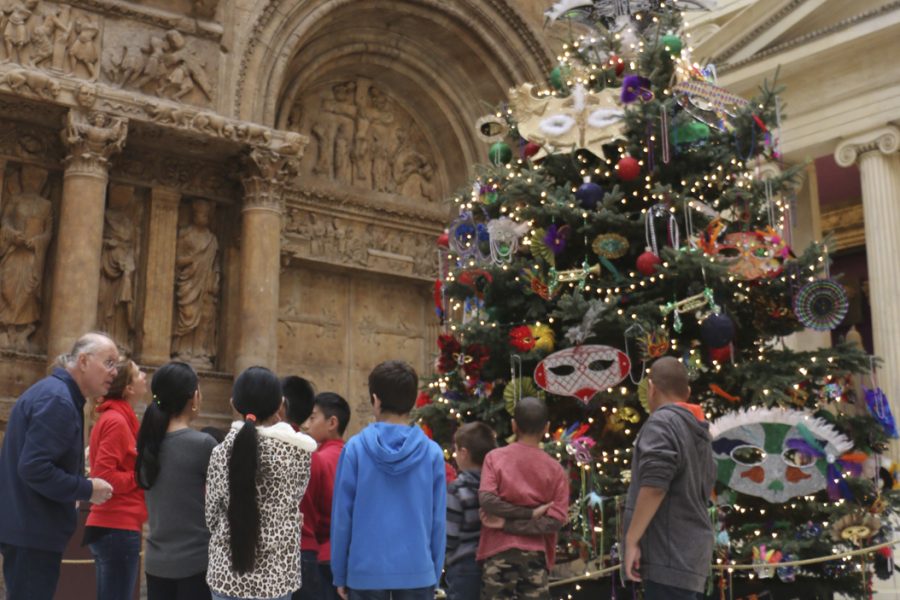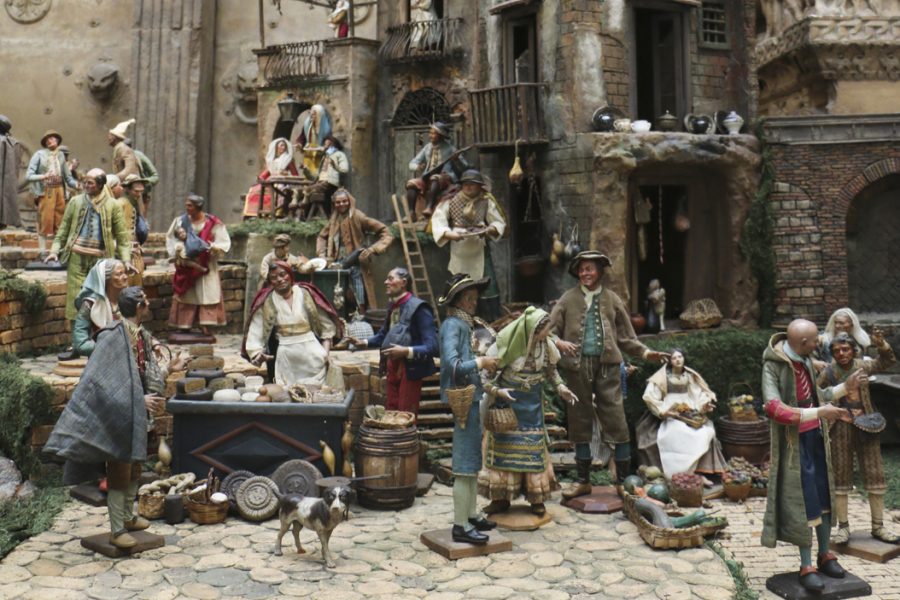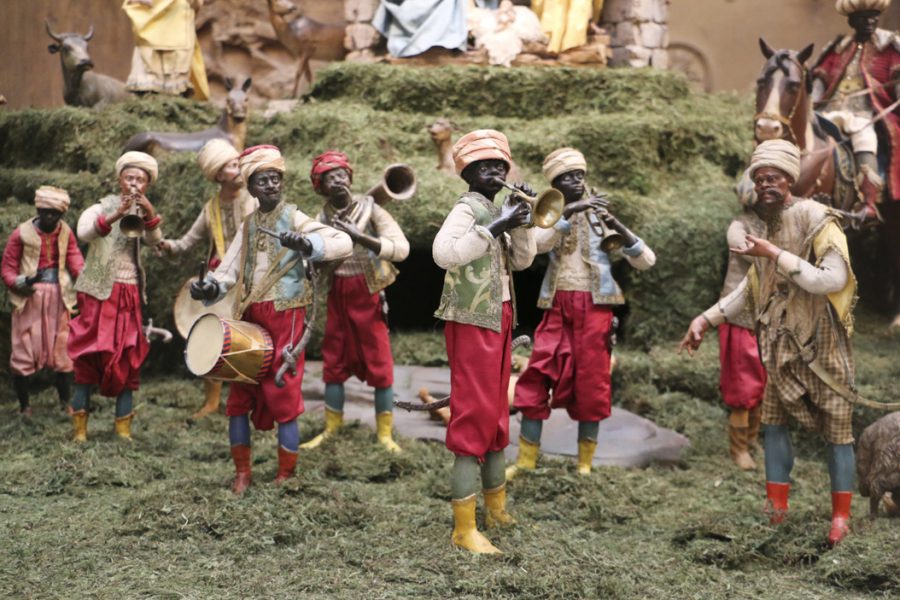The Carnegie Museum of Art’s holiday display traces its history back to the 1700s, and dwarfs similar collections nationwide, including one at the White House.
The exhibit includes the annual Neapolitan nativity scene, as well as five oversized evergreen trees decorated to fit this year’s theme of “The Americas.” The nativity scene is a presepio — a Christian nativity scene populated with figurines and placed within the context of 18th century Naples — which went on display for the first time in 1957 and has since become a Pittsburgh tradition, according to curator Rachel Delphia.
The exhibit is displayed at the far end of the museum’s high-ceilinged Hall of Architecture. Standing at about waist height is a platform, longer across than it is deep like a dining room table. The museum staff built a landscape of green moss and cobblestone paths where figurines are frozen while walking, talking and going about their business. On the left half of the presepio is the classic Christian nativity scene, complete with baby Jesus in a manager. On the right half of the exhibit is a scene from what would have been daily life in Naples in the 1700s, with some of the townspeople interacting with one another while others turn their heads to look at the distant manger scene.
Delphia — the Alan G. and Jane A. Lehman Curator of Decorative Arts and Design at the museum — said the presepio display is one of the largest in the country and features dozens of nearly 300 year-old terra-cotta figures with life-like glass eyes.
The Carnegie Museum of Art’s staff, including curator Rachel Delphia, set up the presepio exhibit. Carnegie Museum of Art. | Courtesy of Jonathan Gaugler.
The presepio’s smaller-than-life scale is juxtaposed by five larger-than-life evergreens that tower over the exhibit at about 20 feet tall each.
In a tradition that goes back 56 years — nearly as long as the museum has displayed the presepio exhibit — each tree is decorated to fit with a different theme. To fit with the exhibit’s theme of “The Americas” the trees are decorated to represent various countries: hot dogs for the United States, regional flags for Canada, carnivale masks for Brazil, monarch butterflies for Mexico and amphibians for Peru.
The museum’s Women’s Committee, which is a separate organization committed to raising funds and organizing programs for the Carnegie Museum, puts on the tree project each year, according to the organization’s president, Mary Margaret Stamy.
Each tree weighs about one ton and is hefty enough that they each need to be anchored in wooden bases and also held upright by wires attached to beams in the ceiling.
“Think about your own Christmas tree, and then multiply it by at least two and a half or three times,” Stamy said. “There isn’t a stand that would keep them upright, [so] they’re basically suspended from the ceiling.”
The trees flank the presepio exhibit on either side, creating a funnel that leads visitors to the Neapolitan piece.

Delphia said many of the figures were crafted in the 1700s, when the presepio first became popular. A century later, as the various states in the region united to become one Italy, the social “turmoil” meant some of the wealthier families lost their status and financial stability. Because of this, many formerly wealthy owners of massive presepios broke up and sold their collections.
Presepios became popular again during this time, as individuals and families — including a Neapolitan family by the name of Catello — purchased figurines and built their own collections. Eugenio Catello sold off his family’s collection in the 1950s, and the pieces went in part to the Carnegie Museum of Art and in part to the Metropolitan Museum of Art in New York City.
“The Catello family started collecting in this mid-19th century moment,” Delphia said. “It was really some of the financial hardship that the family faced after World War II that led Eugenio Catello to sell off some of the family collection.”
Although the Carnegie Museum acquired its pieces from only one source, the Catello family had collected the pieces they owned, so it’s not clear how many of the pieces were originally commissioned together or created by the same artist.
“We don’t know the source, we don’t know which collections the Catellos patronized and pulled from in terms of the original collections,” Delphia said. “But based on the coordinated textiles in a number of the costumes, it’s clear that at least a core group of these figures has been together since the 18th century.”

Mary Ewalt, who has been a docent — a tour guide available to answer visitors’ questions — at the Carnegie Museum for more than 14 years, said the presepio shows two different worlds colliding. A river divides the religious side with the nativity scene from the secular side with a scene from an average day in Italy. The two sides remain connected by bridges over the water.
“[One side] is daily life in Naples [and the other] is the Biblical story of Christ. And when they interact, some people are watching and some [figurines] are clueless about this dramatic event that’s occurring,” Ewalt said.
Both the division and interaction within the exhibit can be seen in the contrast between the procession of the magi visiting baby Jesus on the religious side and the procession of a Turkish band through the streets of Naples on the secular side of the presepio.

Although the Carnegie Museum’s exhibit is extensive compared to other collections in the White House, the Art Institute of Chicago and the Milwaukee Art Museum, Delphia said they are still lacking the smallest size of figurines meant to inhabit the furthest back sections of the presepio’s tiny world.
The figurines can range from seven to 13 inches, which creates “an exaggerated sense of perspective” according to Delphia. Although the museum has only a few of the smallest figurines, Delphia said her primary goal is to maintain and preserve the current collection, not necessarily to expand it.
“[The presepio is] extremely fragile … and it’s been on view here every year for 60 years,” Delphia said. “We are also looking at it and saying ‘How do we ensure that this on view for future generations?’”
Although the presepio is itself a “mash-up” of secular and religious scenes, Delphia said the museum’s exhibit is specifically arranged to mimic the way its original 18th century owners would have displayed it, which she said adds a historical richness to the exhibit.
In contrast, the Met takes a different approach to its presepio exhibit by displaying the angel figurines on a large evergreen tree, commonly known as the “Angel Tree.” The Met’s exhibit is beautiful, as Delphia points out, but it also is not in line with the Neapolitan presepio tradition, which didn’t include Christmas trees.
“There’s an authenticity to the way that our scene is presented,” Delphia said. “There’s a lot of decisions that the collectors or the museums putting them on display are making and, you know, they kind of affect the story that’s being told.”


